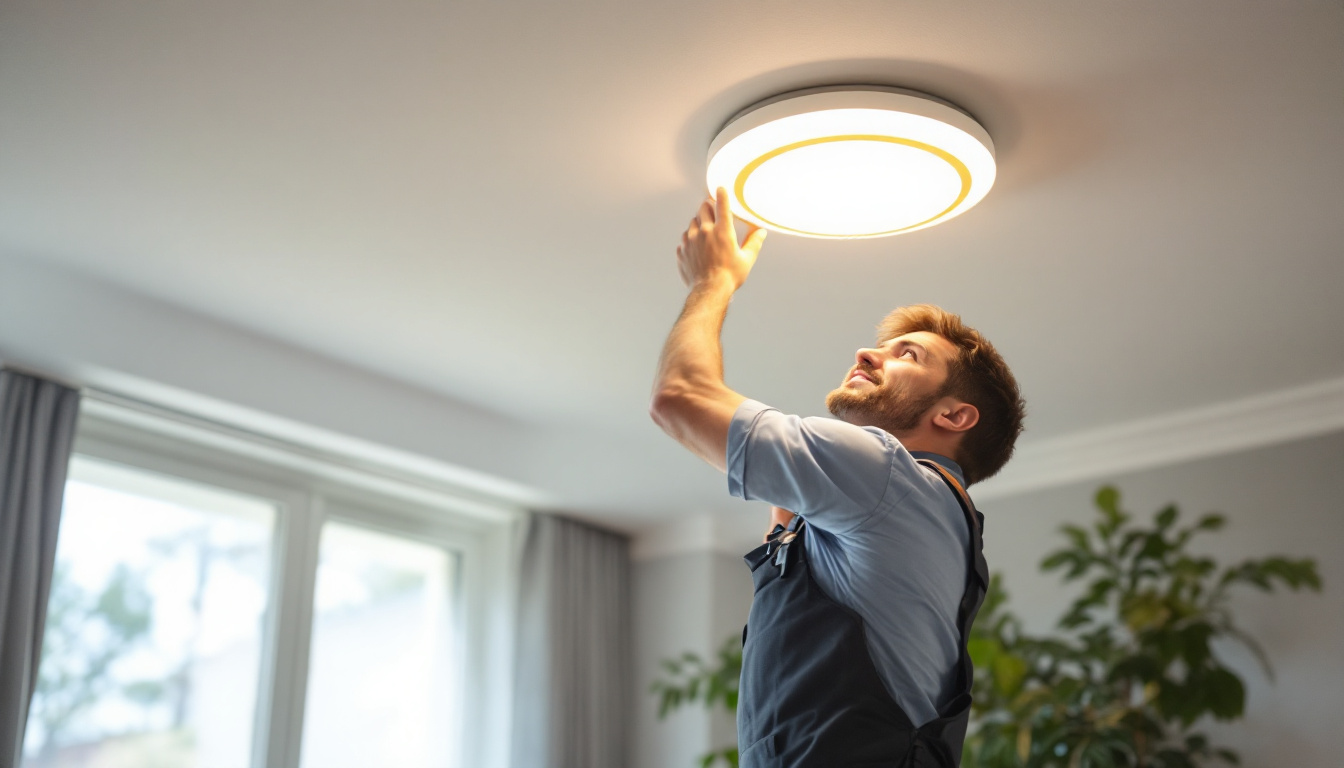
In the ever-evolving world of lighting solutions, recessed lighting has become a staple in both residential and commercial spaces. As a lighting contractor, understanding the benefits and intricacies of LED replacements for recessed lights can significantly enhance your service offerings and profitability. This guide will explore the advantages of LED technology, the process of replacing traditional recessed lights, and how to effectively market these services to clients.
One of the primary benefits of LED recessed lighting is its remarkable energy efficiency. LEDs consume significantly less power than traditional incandescent or fluorescent bulbs, often using up to 80% less energy. This reduction in energy consumption not only benefits the environment but also translates to lower electricity bills for homeowners and businesses alike.
For lighting contractors, promoting energy efficiency can be a strong selling point. Clients are increasingly aware of their carbon footprints and are looking for sustainable solutions. By highlighting the long-term savings associated with LED lighting, contractors can position themselves as environmentally conscious professionals who provide value beyond mere installation. Additionally, many local governments and utility companies offer incentives or rebates for switching to energy-efficient lighting, which can further entice clients to make the switch and enhance the contractor’s appeal as a knowledgeable resource for navigating these opportunities.
LED lights have a much longer lifespan compared to traditional lighting options. While incandescent bulbs may last around 1,000 hours, LEDs can last anywhere from 15,000 to 50,000 hours or more. This longevity means fewer replacements and maintenance calls for contractors, allowing for a more streamlined service experience.
Moreover, LEDs are more durable and resistant to shock, vibrations, and temperature fluctuations. This resilience makes them ideal for various applications, from residential settings to commercial environments where lighting fixtures may be subjected to harsher conditions. By emphasizing these durability aspects, contractors can reassure clients of the reliability of their lighting investments. In addition, the reduced frequency of bulb replacements contributes to less waste in landfills, aligning with a growing trend toward sustainability and responsible consumption that many clients are eager to support.
LED recessed lights offer superior light quality, providing bright, clear illumination without the harshness often associated with traditional bulbs. They come in a variety of color temperatures, allowing contractors to tailor lighting solutions to meet specific client needs and preferences. Whether a warm, cozy ambiance is desired or a bright, daylight-like effect is preferred, LEDs can accommodate these requests with ease.
Furthermore, LED technology minimizes issues such as flickering and buzzing, common complaints with older lighting systems. By showcasing the improved light quality, contractors can enhance client satisfaction and potentially increase referrals and repeat business. The ability to dim LED lights also adds to their versatility, allowing users to adjust the mood and functionality of a space effortlessly. This feature is particularly beneficial in settings such as home theaters or dining areas, where the ambiance can significantly impact the overall experience. By demonstrating these capabilities, contractors can further solidify their reputation as experts in creating tailored lighting solutions that enhance both aesthetics and functionality.
The first step in any recessed light LED replacement project is a thorough assessment of the existing lighting system. This includes evaluating the current fixtures, determining the type of bulbs being used, and understanding the client’s lighting needs. Engaging with clients during this stage is crucial; it allows contractors to gather valuable insights into their preferences and expectations. For instance, some clients may prioritize energy efficiency, while others might focus on achieving a specific ambiance or aesthetic in their space. By taking the time to listen and understand these nuances, contractors can tailor their recommendations accordingly.
Planning the replacement involves selecting the appropriate LED fixtures and bulbs that match the existing layout while considering factors such as brightness, color temperature, and energy savings. Providing clients with a range of options can enhance their decision-making process and foster a sense of ownership over the project. Additionally, presenting visual aids or samples of different lighting effects can help clients visualize the end result, making them more confident in their choices. This collaborative approach not only ensures satisfaction but also sets the stage for a successful installation process.
Once the planning phase is complete, the installation process can begin. This typically involves removing the old fixtures and installing the new LED units. It is essential to follow all safety protocols, including turning off power to the fixtures and using appropriate tools and equipment. Moreover, contractors should ensure that the work area is clear and organized to prevent accidents and facilitate a smooth workflow. Taking these precautions not only protects the workers but also reassures clients about the professionalism of the service being provided.
During installation, contractors should pay attention to the positioning of the new lights. Proper placement can significantly impact the overall lighting effect and client satisfaction. Ensuring that the lights are evenly spaced and directed towards key areas can enhance the functionality and aesthetic appeal of the space. Furthermore, considering the room’s purpose—whether it’s a cozy living area or a bright workspace—can guide the placement strategy. By optimizing the lighting layout, contractors can create a harmonious balance that meets both practical needs and design aspirations, ultimately elevating the client’s experience in their newly lit environment.
After the installation is complete, a follow-up with the client is vital. This step not only demonstrates professionalism but also provides an opportunity to address any concerns or questions. Encouraging feedback can help contractors improve their services and build stronger relationships with clients. It can also be beneficial to schedule a follow-up visit a few weeks after installation, allowing clients to fully experience the new lighting and share their thoughts on its performance. This proactive approach can lead to valuable testimonials and referrals, further enhancing the contractor’s reputation in the community.
Additionally, providing clients with information on the maintenance and care of their new LED fixtures can enhance their experience. Educating them on the longevity and efficiency of LEDs can also reinforce their decision to invest in this technology. Offering tips on how to clean the fixtures, adjust settings, or troubleshoot common issues can empower clients to take ownership of their lighting system. Moreover, providing a warranty or service plan can give clients peace of mind, knowing they have support should any problems arise. This comprehensive approach not only solidifies the contractor’s commitment to customer satisfaction but also encourages a long-term relationship built on trust and reliability.
To effectively market LED replacement services, contractors need to identify their target markets. Residential clients, commercial businesses, and even industrial facilities all have unique lighting needs and budgets. Understanding these differences can help contractors tailor their marketing strategies to resonate with each audience.
For instance, residential clients may be more interested in aesthetic appeal and energy savings, while commercial clients might prioritize functionality and cost-effectiveness. By segmenting the market, contractors can create targeted campaigns that address the specific concerns and desires of each group.
In today’s digital age, having a strong online presence is essential for any contractor. Utilizing digital marketing strategies can significantly enhance visibility and attract new clients. This includes optimizing a website for search engines, engaging with potential clients on social media, and utilizing email marketing to keep in touch with past customers.
Creating informative content, such as blog posts or videos about the benefits of LED lighting, can position contractors as industry experts. Sharing success stories and testimonials from satisfied clients can further build credibility and trust.
Building relationships within the industry can open up new opportunities for contractors. Networking with other professionals, such as electricians, architects, and interior designers, can lead to referrals and collaborative projects. Additionally, forming partnerships with suppliers of LED products can provide contractors with access to the latest technology and competitive pricing.
Attending industry trade shows and local business events can also enhance visibility and foster connections. These interactions can lead to valuable insights into market trends and client preferences, helping contractors stay ahead of the competition.
Despite the numerous benefits of LED lighting, some clients may be hesitant to switch from traditional fixtures. This resistance can stem from a lack of understanding of the technology or concerns about the initial investment. Lighting contractors must be prepared to address these concerns with clear, factual information.
Offering demonstrations of LED products or showcasing case studies of successful installations can help alleviate fears and build confidence in the transition. Providing a breakdown of long-term savings can also persuade clients to embrace LED technology.
Another challenge that contractors may face during LED replacements is compatibility with existing fixtures and systems. Not all recessed lighting fixtures are designed to accommodate LED bulbs, which can lead to complications during installation. It is crucial for contractors to be knowledgeable about the various types of fixtures and their compatibility with LED technology.
In some cases, retrofitting existing fixtures may be necessary, which can add to project costs and complexity. Being transparent with clients about these potential issues can help manage expectations and foster trust throughout the process.
The lighting industry is constantly evolving, with new technologies and trends emerging regularly. For contractors, staying informed about these changes is essential to remain competitive. This can involve ongoing education, attending workshops, and engaging with industry publications.
By staying ahead of the curve, contractors can offer the latest solutions to clients, ensuring they are providing the best possible service. This commitment to continuous improvement can also enhance a contractor’s reputation as a leader in the field.
Recessed light LED replacement presents a significant opportunity for lighting contractors to boost profits while providing clients with superior lighting solutions. By understanding the advantages of LED technology, mastering the replacement process, and effectively marketing these services, contractors can position themselves for success in a competitive market.
While challenges may arise, embracing the future of lighting and adapting to industry trends will ensure that contractors remain relevant and profitable. As the demand for energy-efficient and high-quality lighting continues to grow, those who invest in LED replacement services will undoubtedly reap the rewards.
In conclusion, the shift towards LED recessed lighting is not just a trend; it is a fundamental change in how lighting is perceived and utilized. Lighting contractors who recognize and adapt to this shift will not only enhance their service offerings but also contribute to a more sustainable future.
Ready to elevate your lighting game and drive your profits higher? At LumenWholesale, we’re committed to equipping you with the finest spec-grade LED lighting products at prices that can’t be beaten. Say goodbye to middleman markups and hello to an extensive selection of reliable, high-performance lighting that meets the most stringent industry standards. With free shipping on bulk orders, we ensure you get the premium quality you deserve at the best value. Don’t settle for less—choose LumenWholesale for a seamless blend of quality, affordability, and convenience. Wholesale Lighting at the Best Value is just a click away.

Discover essential compliance guidelines for LED tape lights that every lighting contractor should know.

Discover expert tips and common mistakes to avoid when selecting and installing electrical boxes for light fixtures.

Discover how external lamps can revolutionize your lighting projects by boosting efficiency and enhancing illumination quality.

Discover essential tips from lighting contractors on choosing and installing commercial electric lamps efficiently.